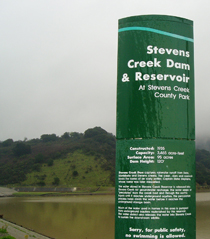Seismic Stability Evaluation of Stevens Creek Dam
Santa Clara County, California
Owner:
Santa Clara Valley Water District

Stevens Creek Dam is a “High Hazard” dam located in a highly seismic area, with the San Andreas Fault 2.3 miles away, and a potentially liquefiable foundation.
TERRA is leading a multi-disciplinary team of consultants retained by the Santa Clara Valley Water District (SCVWD) to complete seismic stability evaluations of Chesbro, Lenihan, Stevens Creek and Uvas Dams. The general scope of the project consists of field, laboratory, and office studies required to evaluate the seismic stability of the dams.
Stevens Creek Dam, classified by the Division of Safety of Dams (DSOD) as a “High Hazard” dam, is a 132-foot high earthfill structure that was constructed across Stevens Creek in 1935. Major modifications were made in 1986 to address seismic stability and spillway capacity issues. Two faults control the seismic hazard at the dam: the Stanford-Monte Vista and San Andreas faults. They are located 1.0 and 2.3 miles from the dam and can generate magnitude 6.9 and 7.9 earthquakes, respectively.
The key technical concern at the dam is the presence of gravelly alluvium beneath the downstream portion of the dam. The site investigations showed that the alluvium is functioning as a very effective drainage blanket beneath the downstream shell of the compacted clay dam. Finite element seepage analyses showed that the presence of the alluvium drainage layer significantly reduces piezometric levels within the dam and alluvium, and causes a substantial increase in the strength of the clay embankment and alluvium. The liquefaction resistance of the alluvium was difficult to characterize because of the potential effects of gravel on test results and required extensive interaction with DSOD to work constructively with the regulators and agree on a characterization of the alluvium that was conservative and would provide a robust seismic evaluation of the dam, while avoiding the over-conservatism that could lead to costly and unnecessary seismic remediation.
Non-linear seismic deformation analyses of the dam that considered 24 different input ground motions showed that the maximum estimated permanent deformations of the dam were 3 to 4 feet and we concluded that these deformations would not endanger the safety of the dam.








